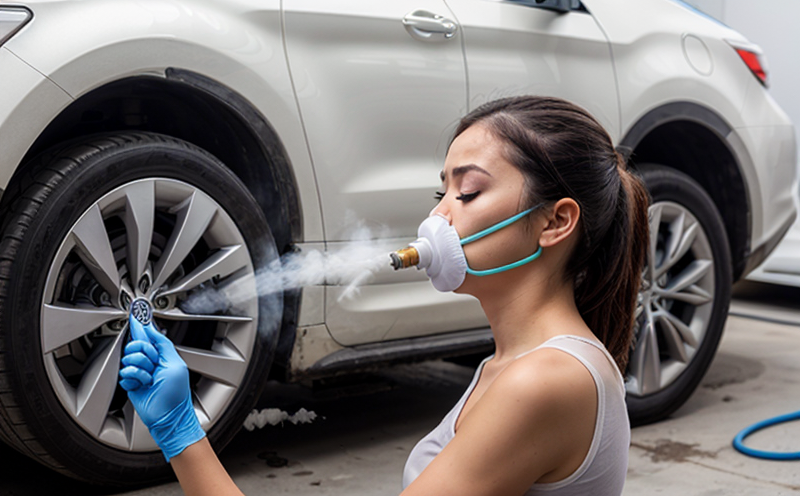EN 16516 Indoor Air Emission Testing of Construction Products
The European Standard EN 16516 is a critical tool in ensuring the quality and safety of indoor air environments. This standard sets forth detailed guidelines for determining volatile organic compounds (VOCs) emissions from construction products that are used in indoor spaces such as offices, schools, and hospitals.
The primary goal of EN 16516 is to protect human health by minimizing exposure to harmful chemicals released into the air. By adhering to this standard, manufacturers can ensure their products meet stringent emission limits, thereby contributing to a healthier indoor environment for occupants.
The testing process involves placing samples of construction materials in an enclosed chamber under controlled conditions that simulate real-world usage scenarios. VOCs are then measured over time using advanced analytical techniques like gas chromatography-mass spectrometry (GC-MS). This allows testers to quantify the emissions accurately and compare them against specified limits outlined in EN 16516.
It's important to note that this standard applies not only to building materials but also to finishes, adhesives, sealants, coatings, and other products that could contribute to indoor air pollution. The testing procedure is designed to be comprehensive, covering multiple stages of product lifecycle from raw material selection through final application.
Once the test results are available, they must meet strict emission thresholds set forth by EN 16516. Compliance ensures not only regulatory adherence but also enhances brand reputation among consumers who value sustainable and healthy living spaces.
- Ambient Temperature and Relative Humidity: Controlled conditions are crucial for accurate testing results, typically maintained at 23°C ± 2°C with relative humidity between 50% and 60%.
- Testing Duration: The duration varies depending on the type of material being tested; however, it generally ranges from 7 days to 14 days.
- Emission Limits: Specific limits are defined based on the category of product and its potential impact on indoor air quality.
Understanding these parameters helps stakeholders make informed decisions about which products best align with their environmental goals and regulatory requirements. For instance, specifying materials that comply with EN 16516 can help architects design healthier buildings while satisfying local regulations.
In conclusion, implementing EN 16516 ensures not just compliance but also promotes a safer environment for occupants by reducing harmful VOC emissions from construction products. As awareness grows about the importance of good indoor air quality, standards like this become increasingly relevant in guiding both industry and consumers towards more responsible choices.
Why It Matters
The significance of EN 16516 cannot be overstated when it comes to protecting public health. Indoor air pollution is a major concern worldwide, with studies linking poor IAQ to various respiratory issues and other health problems. By adopting this standard, organizations can significantly reduce the risk associated with harmful emissions from construction materials.
For quality managers responsible for maintaining high standards within their facilities or products, adhering to EN 16516 provides peace of mind knowing that they are meeting international best practices. Compliance also offers a competitive advantage by demonstrating commitment to sustainability and occupant well-being.
In addition to health benefits, there are economic advantages as well. Consumers increasingly demand transparency regarding the environmental impact of products they purchase. Businesses that prioritize sustainable practices often see increased customer loyalty and higher sales volumes due to positive brand associations. Moreover, regulatory non-compliance could lead to costly fines or legal actions.
From an R&D perspective, EN 16516 serves as a valuable resource for innovation. Researchers can use this standard to develop new materials that not only meet emission limits but also enhance performance and durability of the final product.
The importance of ensuring good indoor air quality extends beyond physical health; it impacts mental well-being too. Studies suggest that better IAQ correlates positively with productivity, satisfaction, and overall job performance in workplaces. Thus, implementing standards like EN 16516 contributes to creating more comfortable and productive environments.
Benefits
The implementation of EN 16516 brings numerous benefits across various stakeholders involved in the construction industry. Here’s how compliance with this standard positively impacts different parties:
- Healthcare Providers: Reduces risks associated with indoor air pollutants, leading to improved patient outcomes and reduced healthcare costs.
- Educational Institutions: Creates safer learning environments for students and staff, promoting better academic performance and overall health.
- Office Workers: Enjoy enhanced productivity levels due to increased comfort and concentration resulting from cleaner air.
- Manufacturers: Enhances brand reputation by showcasing commitment to sustainability and occupant well-being. This can lead to increased market share and customer loyalty.
Beyond these direct benefits, there are broader societal gains as well. Cleaner indoor air contributes positively towards reducing global environmental footprints by promoting resource efficiency throughout the supply chain. Additionally, compliance with international standards like EN 16516 fosters innovation within industries, driving forward new technologies and practices aimed at improving quality of life globally.
Quality and Reliability Assurance
- Consistent Testing Procedures: Adherence to standardized protocols ensures consistent results regardless of who performs the tests, enhancing reliability across different laboratories.
- Accurate Emission Measurements: Rigorous calibration and validation procedures guarantee precise quantification of VOC emissions from construction products.
- Comprehensive Reporting: Detailed reports provide comprehensive insights into both compliance status and areas for improvement, aiding informed decision-making processes within organizations.
The combination of these factors ensures that any product labeled as compliant with EN 16516 genuinely adheres to stringent emission limits. This builds trust among consumers who value reliability and accuracy in environmental claims made by manufacturers.
Moreover, regular audits conducted by independent third parties help maintain high standards over time. These audits ensure continuous improvement and adaptation of testing methodologies as new challenges arise or advancements occur within scientific communities.





